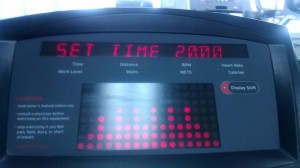Are you someone that just can’t find the time to exercise because of a busy schedule? A bit burned out with the exercise regimen you have been sticking to the last umpteen years and you want a little change? Then, High Intensity Interval Training (H. I. I. T. ) is an aerobic exercise option that is definitely for you! In a nutshell, H. I. I. T. is short high-intensity rounds of aerobic exercise immediately followed by matching recovery periods. My Dad, unknowingly, started my interest in interval training. I was a fat kid that did not exercise. He introduced me to the interval method very gradually: walk 10 paces then walk fast 10 paces. I eventually took off and made running my go-to for exercise because of Dad’s precious gift. I later learned about the science of H. I. I. T. many years later at a medical convention. I’ve just recently reintroduced it back to my exercise routine and I have to say, I love it!
The BIG benefit H. I. I. T. offers over moderate aerobic exercise is substantially LESS TIME for the same (or close to) aerobic benefit. Michael Bracko, Ed.D., FACM from the American College of Sports Medicine says “The real advantage of H. I. T. T. versus distance training is that you can get the same benefits- such as fat loss, improved muscle function, increased oxygen consumption and improved anaerobic capacity-but you don’t have to exercise as long.” Research (Metabolic Adaptations to Short-term High Intensity Training: A Little Pain for a Lot of Gain? ) supports a time requirement less than 1/5th that of traditional endurance training while improving both aerobic capacity and exercise performance. Read it another way: H.I.I.T. slices 80% off your time commitment! The total time demand for one of these H. I. I. T. sessions is typically less than 30 minutes. It is also recommended that you do these sessions, at most, every other day, to give your body a chance to recover. Just to show you it’s popularity, in a worldwide survey of fitness trends for 2014, The American College of Sports Medicine, H.I.I.T. (for the first time)as the Number 1 Fitness Trend for 2014! Shorter time period was the biggest factor that skyrocketed this trend to the top. Please note though, you should not push yourself past your own personal medical limits with this or any form of exercise. Check with your doctor before starting a program like this; it is definitely challenging. Also, H.I.I.T it slowly. That will also decrease your chances of injury.
Interval training is basically a method of seesawing high intensity and low intensity exercise between aerobic and anaerobic metabolism. The goal here is to create intervals that initially push your body past your “comfortable” aerobic threshold and into anaerobic territory, but only briefly. Then after approaching your absolute maximum (notice, this is according to your level that you feel you can push yourself), you then can have a period of recovery.
So what are the benefits of H. I. I. T. (besides time) over moderate aerobic exercise? :
1. Improving Disease Outcomes-The following is research that points to H. I. I. T. as being a factor in improving the quality of life in select diseased patient populations:
A. Heart Health- In Superior Cardiovascular Effect of Aerobic Interval Training Versus Moderate Continuous Training in Heart Failure Patients it was shown that when testing high intensity against moderate intensity aerobic exercise in heart failure patients, H. I. I. T. made a significantly improved contribution to these patient’s quality of life over moderate exercise.
B. Metabolic Syndrome-Metabolic syndrome is a culmination of select risk factors that has been associated with chronic disease, i.e. heart disease, Type 2 Diabetes. It is rapidly becoming one of the most serious and prevalent health issues of our time. In Aerobic Interval Training Versus Continuous Moderate Exercise as a Treatment for the Metabolic Syndrome, moderate exercise was tested against H. I. I. T. in patients with metabolic syndrome. Both methods of exercise aided the patients in weight loss and lowered blood pressure. However, H. I. I. T. was superior in improving in all other aspects of reversing metabolic syndrome, i.e. improved endothelial and insulin response and reducing blood glucose and fat storage in adipose tissues. These are the real denizens of this disease.
2. Increases endurance- Pushing our muscles to that anaerobic level triggers the body to produce lactic acid, which allows energy production to continue for a limited amount of time, with an additional accumulation of lactic acid. Maybe you’ve already experienced that burning sensation that accompanies lactic acid production. Please know that lactic acid production is not the “bad guy” it’s made out to be, it’s actually a defense system for the body during anaerobic exertion to prevent permanent damage (see Why Does Lactic Acid Build Up in Muscles? And Why Does It Cause Soreness?). With a steady diet of H. I. I. T. in your exercise regimen, you increase your Lactate threshold, thereby improving your body’s ability to handle lactic acid build-up in your muscles.
3. Boosts metabolism- You will be working close to your VO2 Max (that is the ultimate quantity of oxygen consumed by your body during exercise) with the sprint portion of these intervals. Working your body near the V02 Max sparks the afterburn effect. The afterburn effect, a/k/a EPOC, or Excess Post Exercise Oxygen Consumption. The afterburn effect (EPOC) is the extra consumption of fuel by the body to make up for the oxygen deficit that occurs when reaching the anaerobic portion of this exercise. Here is an example of different V02 levels and the afterburn (EPOC) effect of calories burned (see Exercise After-Burn: Research Update):
Phelian et al. (1997) investigated the effects of low intensity (50% VO2 max) and high intensity (75% VO2 max) exercise on the EPOC response. Although the energy cost of both exercise bouts was 500 calories, the higher intensity bout caused a significantly higher EPOC than the lower intensity bout (9.0 liters, 45 calories versus 4.8 liters, 24 calories).
This study underscores the superior afterburn effect of H. I. I. T. versus moderate exercise, even though the amount of calories burned during the initial exercise was exactly the same.
4. Challenging– You are in charge here. There is something uniquely satisfying about the challenge aspect of this exercise. It is my opinion that if you challenge yourself in the exercise realm, it spills over to every other component of your life. But also know that if you choose to do your H. I. I. T. sessions only once per week or the max of every other day, that is okay. Either way, you will see the benefits.
5. No equipment necessary, except:
6. You can do it anytime and anywhere. It’s up to you. You can do it in the pool, the gym, your basement, your front room, the street in front of your house. The possibilities are endless.
That reminds me of the book “Green Eggs and Ham” by Dr. Suess(x):
And you can do H. I. I. T. in a boat
And you can do H. I. I. T. with a goat
And you can do H. I. I. T. in the rain
And you can do H. I. I. T. on a train
Please note, there are no hard and fast rules for the times of the intervals you must follow. I’m going to give you some sample drills, but that is all they are, just ideas for you. If instead you don’t want to follow a time limit, try this method (I’ve done this before too). Do your initial high intensity intervals between landmarks, like this:
And stop your interval at a different landmark:
Then recover, then start all over again with other landmarks for your remaining intervals.
Or you can use the second hand on your watch and time yourself. If you do want just an idea of how H. I. I. T. can be structured, here is a sample of a beginner drill:
1) Warm up at least 5 minutes.
2) 1 minutes of the aerobic exercise of your choice (i.e. run, walk, bike, swim, etc.), pushing your body past it’s comfort zone at about 70% of your maximum heart rate or a 6 using this Perceived Exertion Scale.
3) 2 minutes of recovery using the Perceived Exertion Scale at a Level 4-5
4) Repeat 2) x 3
5) Repeat 3) x 3
6) 3 minutes of cooling down (and don’t forget to stretch)
Total time 20 minutes
Note that in the beginner phase it is recommended that the recovery should be twice the amount of time as the “push” phase. Give your body a chance to adapt to these “intense” portions of the intervals before moving onto challenge yourself more. That approach has two benefits:
a) You will lessen your chance of injury
b) You have a higher likelihood of sticking with your H. I. I. T. program if you don’t burn yourself out in the beginning.
Always remember the goal in healthy living, be it nutrition, exercise or recovery, embrace habits/routines that you can stick with for the long-term. Healthy Living is not a race, it’s a MARATHON!
Here is an example of a more advanced drill when you have mastered the beginner phase:
1) Warm up 5 minutes
2) 2 minutes of aerobic exercise of your choice at about 85% of your maximum heart rate or 8-9 using the Perceived Exertion Scale
3) 2 minutes of recovery at 70% of your maximum heart rate or Level 4-5 using the Perceived Exertion Scale.
4) Repeat 2) x 4
5) Repeat 3) x 4
6) Cool down 5 minutes
Total time 30 minutes
H. I. I. T. should not be performed everyday. Your body needs a chance to recover. Three times per week should be the maximum.
Just to give you an idea of how I fit H. I. I. T. into my life this week:
Monday I did H. I. I.T. on the elliptical at the Scotland County Fitness Center.
Tuesday I only did strength training.
Wednesday I again did H. I. I. T. on the stationary bike in our basement:
Thursday I did a Yoga tape.
Friday was very interesting. We got to our motel in St. Louis at 4 A. M. because Randy had to attend a hospital board meeting the night before (Randy’s Washington University 30th Medical School Reunion was being celebrated on this weekend). Randy forgot to tell me that I needed to attend a luncheon that afternoon. I didn’t bring attire for the luncheon; just a dress for dinner that night. My only option was to purchase an outfit for lunch the next morning (well….there’s a silver lining in every cloud), leaving me a little short on time. I had 30 minutes to spare so I did H. I. I. T. right in our hotel room by speed walking in place before racing out to the store:
Saturday I did a Pilates routine in our room in St. Louis before leaving for Chicago (Randy had a medical conference he needed to attend).
Sunday I did H. I. I. T. on the elliptical in the fitness facility in our motel in downtown Chicago:
I gave you these real life examples to give you a template of how you CAN work H. I. I. T. and any exercise routine into your everyday (yes, sometimes crazy) lives.
Again I need to caution that H. I. I. T. is not for everyone. It really is challenging so if there is any question, talk to you doctor AND use caution. Don’t push your body to the point of injury. It’s not worth it.
However, if you want a workout that will give you a challenge, more time to do the “other things of life”, increases your endurance, maximizes the afterburn effect and definitely boosts your mood, give H. I. I. T. a try!!!
Let me know about your personal story. I’d love to hear from you!!!










[…] posted on DoctorTobbler. Dr. Heliene Tobler Heliene Tobler is founder of Body of Health, a nutritional and lifestyle […]